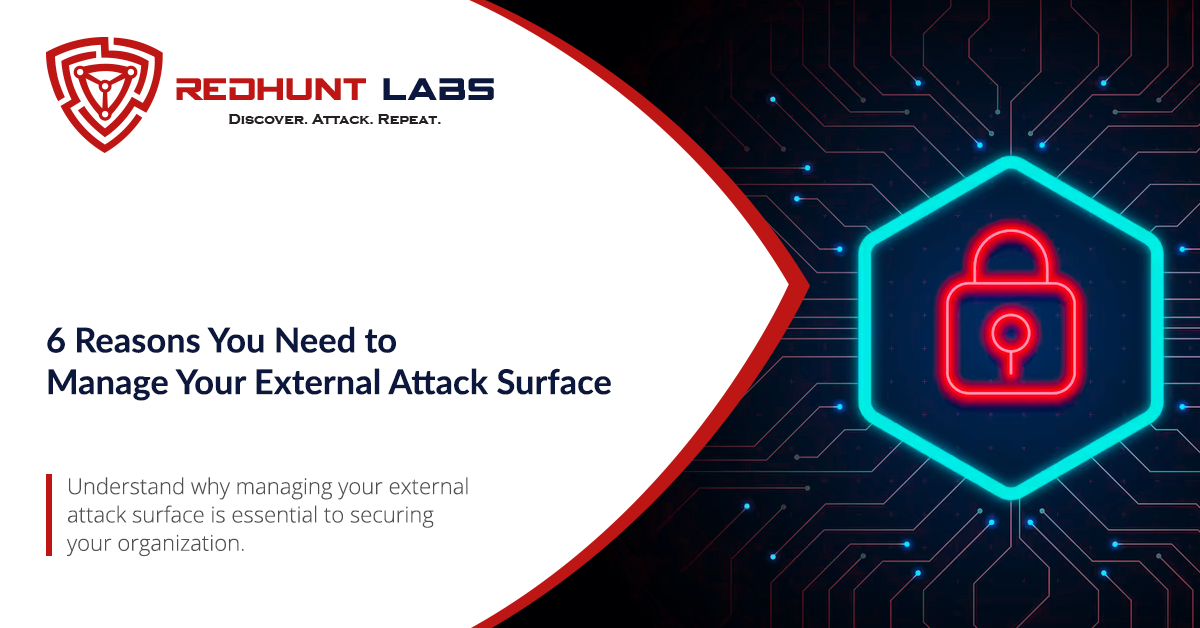6 Reasons You Need to Manage Your External Attack Surface
Introduction
As technology continues to evolve, the digital landscape is becoming increasingly complex. Organizations are adopting new technologies at a rapid pace to keep up with the changing market trends. However, with these technological advancements come new security risks that threaten the confidentiality, integrity, and availability of sensitive information. In this blog post, we will explore why managing your external attack surface is essential to securing your organization.
What is External Attack Surface Management (“EASM”)?
An external attack surface refers to all the digital assets of an organization that are exposed to the internet and can be targeted by cyber attackers. This includes websites, web applications, cloud services, social media accounts, email servers, and other publicly accessible digital assets. An organization’s external attack surface can be vast and complex, with multiple entry points for potential cyber-attacks. Each of these entry points is a potential vulnerability that can be exploited by attackers to gain unauthorized access to the organization’s sensitive information or disrupt its operations. Therefore, it is essential to manage and secure the external attack surface to prevent cyber attacks and protect the organization’s digital assets.
Here are six reasons why you should manage your External Attack Surface:
- Protect Your Organization from Cyber Threats
- Increase Your Visibility
- Avoid Financial Loss
- Compliance with Regulatory Standards
- Protect Your Reputation
- Increase Efficiency in Cyber Security Efforts
1. Protects Your Organization from Cyber Threats:

Managing your external attack surface is essential to protect your organization from cyber threats. Cyber attackers are constantly evolving their tactics and techniques to exploit vulnerabilities in digital assets. By regularly monitoring and assessing your external attack surface, you can identify potential risks and take corrective action to prevent cyber attacks. This can include implementing security patches, updating software, or removing any unnecessary digital assets that pose a risk.
2. Increases Your Visibility

Managing your external attack surface provides you with increased visibility into your organization’s assets and vulnerabilities. This allows you to identify potential risks and take action before they are exploited by attackers. For instance, you can identify unsecured web applications, exposed databases, and other assets that could be used by attackers to gain unauthorized access. By having a complete understanding of your external attack surface, you can make informed decisions to secure your organization’s assets.
3. Avoids Financial Loss:

A data breach or cyber attack can result in significant financial losses for an organization. The costs associated with such an incident can include legal fees, remediation costs, and damage to the organization’s reputation. By managing your external attack surface, you can identify potential vulnerabilities and take corrective action to prevent cyber attacks. This proactive approach can help you avoid the financial losses that result from a successful cyber attack.
4. Compliance with Regulatory Standards:

Many organizations are required to comply with various regulatory standards, such as HIPAA, GDPR, or PCI-DSS. These standards often require organizations to manage their external attack surface and implement security controls to protect sensitive information. Failure to comply with these standards can result in costly fines and penalties. By managing your external attack surface, you can ensure that your organization complies with these regulatory standards and avoids any legal or financial repercussions.
5. Protects Your Reputation:

A successful cyber attack can severely damage an organization’s reputation. Customers and stakeholders expect organizations to take appropriate measures to protect their sensitive information. By managing your external attack surface, you can identify potential vulnerabilities and take corrective action before a cyber attack occurs. This proactive approach can help you protect your organization’s reputation and maintain the trust of your customers and stakeholders.
6. Increases Efficiency in Cyber Security Efforts

Managing your external attack surface can increase the efficiency of your organization’s cybersecurity efforts. By identifying and removing any unnecessary digital assets that pose a risk, you can reduce the complexity of your external attack surface. This, in turn, can make it easier to manage and secure your organization’s digital assets effectively. By streamlining your cybersecurity efforts, you can reduce the workload of your security team and allocate resources more efficiently.
Conclusion:
In conclusion, managing your external attack surface is essential to protecting your organization’s sensitive information and assets. By proactively identifying potential risks and taking corrective action, you can prevent cyber attacks, comply with regulatory standards, protect your reputation, avoid financial losses, and increase efficiency. As the digital landscape continues to evolve, it is critical to stay on top of your organization’s external attack surface and ensure that your cybersecurity efforts are up-to-date and effective.


